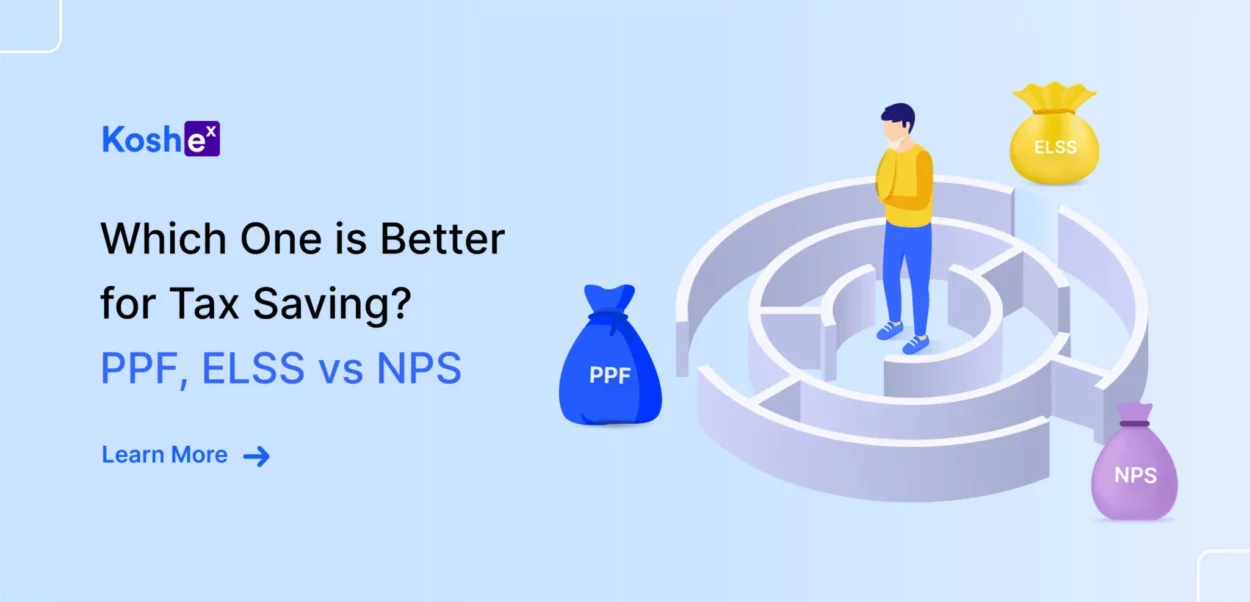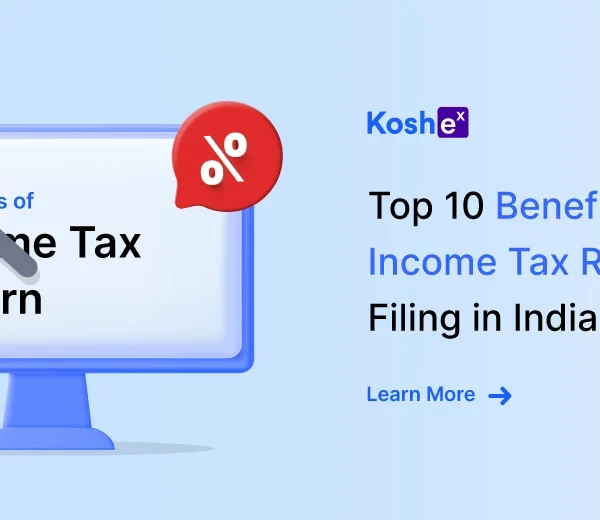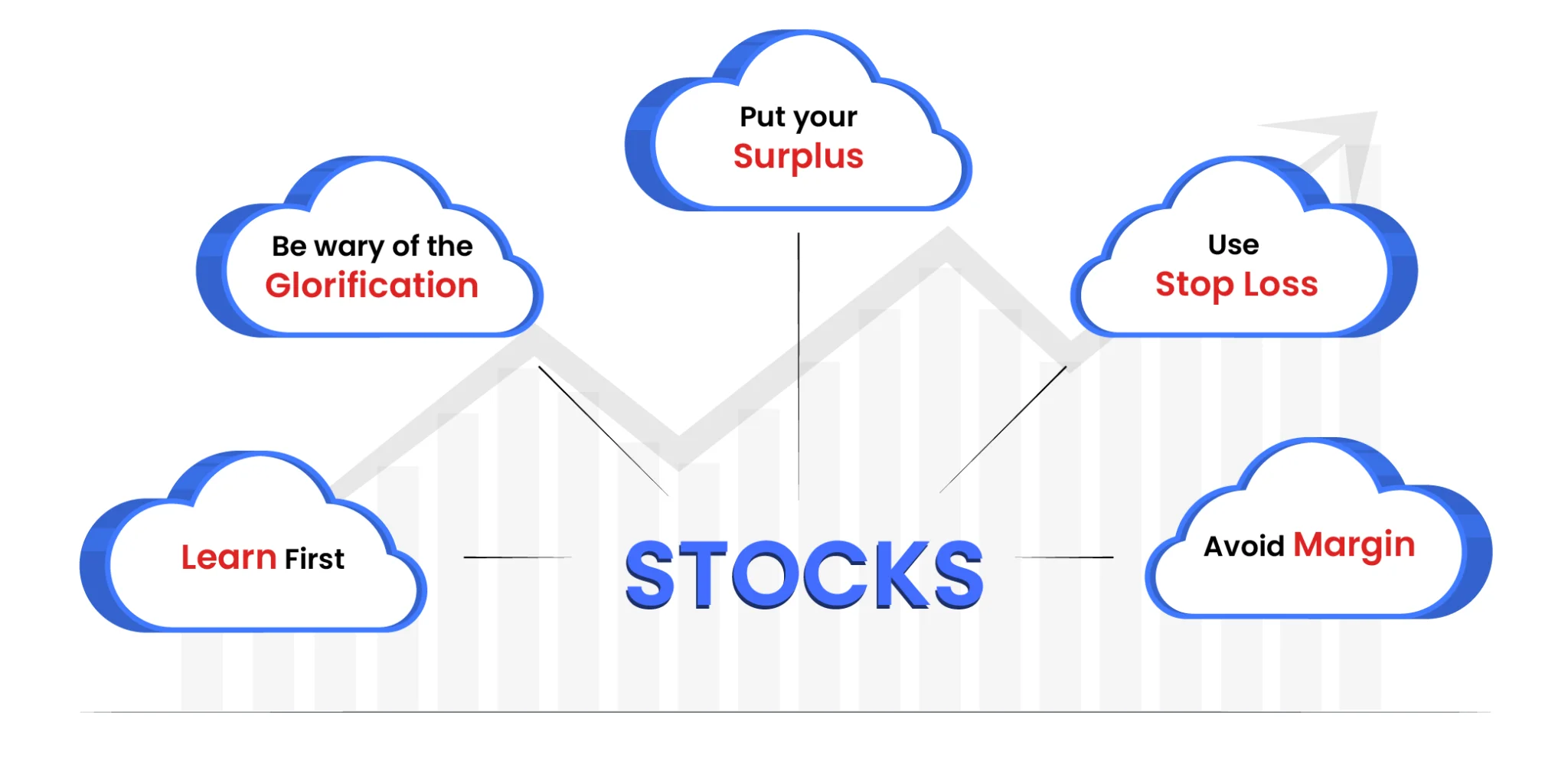The end of the financial year in India is marked by people gathering investment proofs to submit to the IT department.
Many people do not have enough knowledge of tax planning and end up investing in schemes that do not align with their financial goals.
It is necessary to devote some time to compare the different tax-saving instruments depending on the risk appetite and return expectations.
Public Provident Fund (PPF), Equity-Linked Savings Scheme (ELSS), and National Pension System (NPS) are some of the popular long-term investment options in India.
Let’s take a look at how the three look from the point of tax benefit under Section 80 CC of the Income Tax Act of 1961.
Sign up with Koshex and get started with your financial journey in less than 2 minutes.
PPF, ELSS and NPS: Features
- PPF or Public Provident Fund: Public Provident Fund invests in debt instruments, which facilitates long-term savings. PPF schemes were introduced in 1968. It offers a triple tax-saving benefit and allows risk-free investments for a long duration. The upper limit of ceiling investment in PPF schemes per financial year as per the Indian Income Tax Act of 1961 is Rs 1,50,000. The current PPF rate is 7.10% p.a. The returns on PPF schemes are linked to the 10-year government bonds. The returns change at the beginning of the quarter based on the average bond yield during the preceding three months.
Features
- There is a minimum lock-in period of 15 years from the start of the investment, which can be extended by a period of 5 years. Premature withdrawal is allowed only in the case of emergencies.
- For Q3 2022, the interest rate is fixed at 7.1% p.a. Every month after the 5th, interest is calculated until the end of the month. The same interest is credited on the last day of the financial year.
- People can invest as minimum as Rs 500 in PPF.
- Investors are eligible for loans against PPF after the completion of one year but before the end of the 5th year. The maximum loan amount is limited to 25% of the PPF amount at the end of the second year. Exemption from Tax liabilityPPF falls under the Exempt-Exempt-Exempt category under the Indian Income-tax Act. There are three exemption levels:-
- The amount invested in PPF schemes up to Rs 1,50,000
- The yearly interest earned on PPF accounts is not taxable.
- The final payout of the accumulated amount after maturity is all tax-exempt.
2. National Pension Scheme (NPS):
It combines an investment and a pension plan approved by the government. NPS is supervised by the Pension Fund Regulatory and Development Authority. This scheme applies to all employees from the government, public sector, private sector, and even the unorganized sector.
The NPS schemes invest in equity and debt market-linked instruments. The blended return on NPS schemes is 8%-10% of the contributions made.
Sometimes the returns can even be as high as 9%-12% due to the equity component of the investments.
In NPS schemes, the employer also contributes up to 14% in the case of government sector employees. Employers’ contribution of up to 10% for private sector employees is tax-free. Any contributions above that are taxable.
Features
- People can invest up to Rs 1. 5 lakhs in NPS and claim 50,000 in tax deductions under Section 80 CC of the Indian Income Tax Act of 1961.
- NPS schemes invest in equity and debt instruments and earn a blended return between 9%- 12% p.a.
- Investors between 18–70 years can benefit from NPS.
- Premature withdrawals of up to 25% of the contributed amount can be made from 3 years of opening the account. One can withdraw up to three times in five-year intervals during the entire life of the NPS scheme.
- Only 60% of the accumulated amount can be withdrawn after 60 years. 40% of the amount is retained in the scheme. Investors receive regular annuities from the Pension and Retirement Fund Development Authority of India, which is used to pay regular pensions.
Exemption from Tax liability
There are no taxes on annual contributions up to Rs 1,50,000 or 60% of the accumulated amount that can be withdrawn after our retirement. The annuity payments from 40% of the accumulated corpus are taxable.
We can allocate up to 50% of our investments in equities and choose the pension fund and our investment option. It is an active choice method where we can exercise our discretion.
In the auto choice method, investments are made considering our age and risk profile. NPS schemes also qualify for an additional deduction of Rs 50,000 under Section 80CCD (1B) of the Income Tax rules.
3. Equity-linked savings Schemes (ELSS):
These are equity-linked mutual fund schemes that allow us to avail of tax deductions. The main advantage of ELSS savings schemes is that it has only a 3-year lock-in period.
The main investments in equities are made in underlying equity funds. The returns benefit from the power of compounding.
Investments made in this scheme are also eligible for tax deductions up to Rs 1,50,000. There is no limit on the amount of investment.
Features
- Higher returns potential: As ELSS funds invest in equities, we can earn considerably higher returns than in other tax savings schemes.
- Tax deductions: Our contributions are tax-free, up to Rs 1,50,000. The accumulated corpus, invested in ELSS schemes, is also tax-free after the 3-year lock-in period expires. Dividends are tax-free. Capital gains after the expiry of the 3-year lock-in are taxable at 10% as long-term capital gains.
- We can invest any amount in ELSS schemes as we desire.
- The underlying investments have the risk-return profile of the equity investments. They are also subject to the risk arising from market volatility.
- ELSS schemes have both the dividend and the growth option. In the dividend option, you can opt for regular cash inflows in the form of dividends. In the growth option, your earnings are accumulated and re-invested.
Conclusion
NPS, ELSS, and PPF are popular options chosen by people looking for retirement-related investments combined with tax-saving benefits.
ELSS schemes invest in equity instruments with the highest long-term appreciation potential. The accumulated corpus can be withdrawn tax-free after three years.
NPS helps people invest in debt and equity, making it a balanced investment scheme with blended returns. The returns are lower than in ELSS schemes but higher than in PPF schemes. 40% of the accumulated corpus paid out as annuities are taxable under NPS.
In PPF, the underlying investments are mainly fixed income. The interest rate is 7.1% p.a. or whatever is fixed by the Indian government for the quarter.
It is an all-exempt category of investments where there is no taxation. However, there is a trade-off between return and tax exemption.
ELSS gives the best combination of high returns and the best tax deductions available considering the investment period.
Compared to ELSS, NPS schemes provide a blended return of debt and equity through up to 40% of the corpus. It is paid out in the form of an annuity and is taxable.
PPF schemes provide tax protection, but their return is capped according to the market interest rates.
In a rising interest environment, PPF yields may rise, whereas equity returns may be volatile in the short run. ELSS ranks the highest as far as returns are concerned. PPF provides the best tax protection.
Sign up with Koshex to start your automated investment journey. At Koshex, we help young investors invest smartly in mutual funds, smart deposits, and digital gold.
FAQs
Which scheme has debt instruments as an underlying investment?
Public Provident Fund (PPF) has debt as an underlying investment.
Which scheme offers better returns, ELSS or NPS?
ELSS investments in equities offer a higher return potential compared to NPS schemes.









Leave a Comment